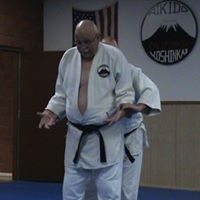
Description
What is Aikido
There are many interpretations into English, and although they sound confusing, they are all probably on the right track. The Japanese character AI means to meet, the character KI means spirit, and DO means the way. When put into order, in English, it might mean something like the way to meet the spirit.
The Aikido practitioner must be at peace with himself before he can create a “harmony” with anyone else. The techniques involving the art of Aikido do not require any excessive amount of strength and rely primarily on the attacking party to provide the force and the momentum necessary to apply the control. It has been said that anyone who can lift sixteen (16) pounds has the strength necessary to study the techniques and the art of Aikido.
Aikido is the study of arm-twists, body-throws, handholds, and other control holds. The origin of Aikido is not entirely clear, but it is known to have been developed hundreds of years ago in Japan by Samurai warriors. Shinra Saburo YOSHIMITSU, a member of the MINAMOTO family, observed the actions of a spider in its web, and is credited as the developer of an art of combat and control. The spider could control enemies larger and stronger than itself with technique.
Master Morihei UYESHIBA (1883 – 1969) is responsible for the teaching of Aikido to the public in modern times. One of his faithful students was Master Gozo SHIODA (1915 – 1994), who held the rank of ninth degree (KUDAN) black belt out of respect to Master UYESHIBA. There were only two (2) ranks given in the tenth degree by 0-SENSEI. Those went to Michio HIKITSUCHI and Koichi TOHEI. SHIODA kancho was commissioned to spread Aikido abroad. He traveled to Borneo and to various parts of Japan. World War II interrupted the study of Japanese martial arts. After the war, SHIODA sensei was asked to teach Aikido techniques to the police of the MITSUBISHI INDUSTRIES As a result of these experiences, SHIODA kancho developed some modifications which were more suitable for police and others in controlling adversaries.
This was the basis for the development of the Yoshinkai School of Aikido. Yoshinkai Aikido is sometimes referred to as the “hard style”. This is due, in part, to the techniques being shortened and applied in a practical manner. The Uyeshiba School of Aikido today retains the classical, flowing gracefulness of the past with the beauty of a dance. Another of Master UYESHIBA’s students, Kenji TOMIKI, was a Judo man prior to his study of Aikido and his style of teaching endeavors to incorporate the spirit of competition into the realm of Aikido.
Many of the techniques today still use the moves, which look like moves a samurai warrior might have used. As you observe some of the Aikido throws and techniques, try to imagine a 2-handed sword in the hands of the person doing the throwing. Occasionally, the one being thrown is grabbed in such a way that his arm may appear to be “the sword”.
The uniform is called a judo-gi or “keiko-gi”, which means, “work-out uniform”. It is the traditional garb used in Japan and around the world today by practitioners of various martial or fighting arts. It has also been called DOGI, meaning “way uniform”. The heavy jacket gives added protection when falling on the mats. The dark skirt worn by some members and instructors is called a “hakama”.
Location
-
501 West Commonwealth Avenue, Fullerton, California 92832, United States of America
Categories
Language
- English

Add a review